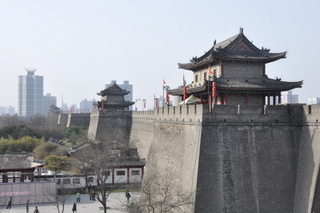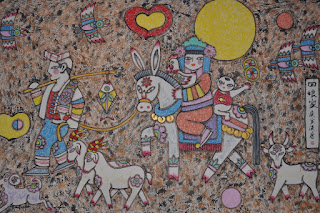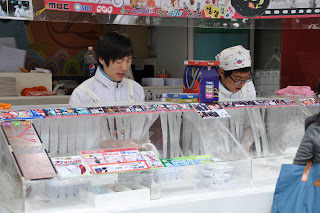Ni-how. That’s Chinese for hello and greetings. This was one hell of an adventure and I have got to say that Regent did this five day post cruise excursion in a first class way. We never had to lug our bags, stand in long lines or wait to get our boarding passes. All we had to do was show up at the appointed time and everything was taken care of. Hotel accommodations were five star and our guides did an outstanding job of arranging everything and teaching us all about China. This is the only way to travel.

Everything in China is BIG and CROWDED. The density in the cities is mindboggling. The first notable item of interest was the highrise apartment buildings. These behemoth-like cities, with buildings that went on for as far as the eye could see representing millions of new living units, were being built where farmland used to be (we couldn't get a good picture of these as the haze was just too thick). As soon as one cluster of buildings is done, they move in thousands of people. You can now buy an apartment, but they are often out of the reach of the young or newly married, so many children still live with their parents. When you buy an apartment, you get the bare walls and floors – no toilets, floors, cabinets – no nothing. One has to be careful of corrupt contractors when “decorating” their units.

The cities are so crowded that the government is actually forcing people to move out of the central business area into these “suburbs.” If they refuse to accept a reasonable compensation to do so, the government forces them out by shutting off the electricity and water, and if necessary, tricking them out of their house by saying a family member was in an accident and is in the hospital. When they return home to find this was a ruse, the house has already been demolished. Yes, they do things in a brutish way sometimes, and the fact that the state owns 100% of the land makes it a lot easier to gravitate to the highest and best use of that land no matter the consequences to the individual.

Everywhere we went in the cities we saw new construction: airports, apartment buildings, offices, subways, freeways, stadiums, museums, and SHOPPING. Lots of high end shopping. We did not have any trouble navigating in the cities and on the freeways as there was English on so much of the signage. In Beijing, all industry was moved out of the city before the Olympics to prevent pollution. And speaking of pollution, they have a really serious problem with it. People have discovered cars. There are still over seven million bicycles and five million cars in Beijing alone. Motorbikes have been banned due to their polluting effects, but motorscooters are allowed. There are so many cars in Beijing that the average speed on Beijing roads is only 17 miles per hour. You cannot go to the car dealership and just buy a car. You have to enter a lottery for a chance to get a car. To cut down on the congestion, the government has mandated that on one day of the week you cannot drive your car; if you get caught by the police or the traffic cameras you get a fine of 100 yuan ($17) for each time you are cited. If you need to go somewhere important on your day of no driving, you can take public transportation or a taxi; however, most people find it cheaper to pay the fine.

The drivers and pedestrians play a nerves of steel game of chicken. It’s take no prisoners, no holds barred. Crosswalks are not safe and pedestrians are fair game; even if you have a green walk sign the drivers don’t pay any attention to it so you have to play dodge car when crossing the street (we learned this first hand the hard way and almost got mowed down). There were rush hour bus wars and even the bicycles with boxes piled high over the back wheel got into the fracas by turning right into the way of oncoming buses. Driving here is not for the faint of heart. I envision a great new video game of Driving in Rush Hour Beijing, where one bus challenges the bus coming up on his right, cutting him off and then making a right hand turn right in front of the cut off bus. Woo wee, what a ride we had.
After so many wars, including the Japanese occupation of China, the population was decimated. The population started to boom uncontrollably and the government, under Mao, put the one child law into effect in 1978. The only exception to this law is if you were an only child and your spouse was an only child, then you could have two children. If you had more than the allotted amount of children, you are fined up to three years’ salary – but you could keep the kid. This applies to the Han people, which comprise 93% of the population. The rest of the 7% of the population is made up of 55 different minorities and this policy does not apply to them. China considers Tibet, Mongolia and Manchuria to be a part of China. Our guide was hesitant to discuss the Tibetan issue.
Some people have wondered why the name of Peking was changed to Beijing. According to our guide, the city was always called Beijing. In the Hong Kong dialect, it was called Peking. Remember, China was a closed to the western world and until recently, the only news of China came out of Hong Kong. When China opened its doors to the west, the proper name of Beijing was then used. The past ten years of so has seen the Chinese economy go from a rural agrigarian society to a capitalist –type of economy. Private business has a strong relationship with the government (can you say kick-backs and corruption). However, the Communist government does not use the word capitalism; they prefer to call it “communism with special Chinese characteristics.” Whatever…. They are surely embracing the entrepreneurial spirit! By the year 2030, it is predicted that 70% of the population will be urbanized.
What we witnessed here is truly an economic miracle. They are advancing their society at a pace every year that takes the western world ten. If you look close, the chocolate cake was decorated beautifully, but inside it tasted awful. Things look good, but they are not concerned with craftsmanship. The Olympics was an incredible motivator to modernize for the world to see, yet the Cube (the swimming venue) is falling apart. The Bird’s Nest Stadium has gone to seed and the seats are falling apart.
The truth is, as big as China may be, they really don’t have enough land, so they make more! As we road from Tianjin to Beijing, we travelled over several thousand acres of land that had been reclaimed from the sea. Had we been here six months earlier, we would have been in the ocean. We passed miles and miles of tens of thousands of newly planted trees along the freeway that was really a nursery; the trees are destined for Beijing for planting as a windbreak for the fierce sand storms from the Gobi Desert that occur in the springtime.
How are they going to feed everyone? With the farmers and rural people moving to the cities and agricultural land being used for development, food is getting expensive. Even street vendors selling food are disappearing as there is no room for them because of too many cars and pollution. The emergency lanes (for police and ambulances) have been taken over by traffic. If you are rushing to the hospital to have a baby, you probably won’t make it.
Wherever we went (we were a group of 52), locals would stare at us. It was quite unnerving at first. They would come up to one or two of us and ask to take OUR picture. They would strike several poses with us in the middle surrounded by three or four Chinese. I held onto my passport and wallet as I didn’t know if they were trying to pickpocket while taking the pictures or not. They seem to be really interested in us. Several times both Michael and I were approached by mostly students who would walk up to us on the street or at the mall and start a conversation. They wanted to practice their English and ask all kinds of questions about America and what we thought of China. I was “invited” to come with them to see their homes, art galleries, etc. No way was I going to go somewhere with a perfect stranger.
This history of China is so big, long and complicated that I could never hope to capture it in a few sentences or paragraphs. The history goes back 3,500 years, with the cradle of civilization starting in the Northwest of the country along the Yellow River. There are 1.4 BILLION people in China. There have been 13 dynasties, with the last emperor living in the Forbidden Palace until 1911. The Chinese invented gun powder, paper, printing, and the compass among other things. In 1949, China underwent a social revolution becoming a communist country, and is now known as the People’s Republic of China. I’ll refer to more history when I describe our excursions.
There is no DIET COKE or diet anything. We had to drink and brush teeth with only bottled water, even in the hotel. I could not bring myself to drink regular coke, so I drank beer. Yeah, me. I drank more beer in these five days than I have in the last ten years. I might even get to like it someday.
Most of my comments so far are general to China and specific to cities. We saw people of all ages doing yoga or other exercise in unhosted groups in city parks and squares. It was cold outside and there they were, working out. It seemed as though most of these were elderly folks. Since the retirement age for women is 50 and for men its 55, I guess that is considered elderly. We also saw store employees in uniform lined up outside on the sidewalk for their daily pep talk and exercise. Since they have taken physical education out of our schools, this seems like a great idea.
And now… ta da … the girls bathrooms. All the places we went to had two feet and a hole pictured on the outside of the door. They would have one or two handicap stalls with toilets that were so low to the ground you might as well have been squatting; some didn’t have a seat, just the rim. Sometimes there were seat protectors and toilet paper. The public rest rooms were not that clean and smelled. There were times when we had to bring the TP with us as not all bathrooms had some. The hotels had western style bathrooms, but the TP was like wiping with a stick of wood. Where is the Charmin??
Most of the public buildings we went to were not heated. We had to wear coats in the museums and the lobby of the hotels we stayed at were also cold. And one other generalization: there was nowhere to sit wherever we went. Standing in one spot while the guide lectured was sometimes torture and the distances we walked were quite vast: walk, stand/talk, walk, stand/talk… and to think that my little walking chair is being enjoyed by someone in Taiwan.
To look at the cities with just a cursory examination, things look pleasant and very western. Many of the shopping areas and restaurants we visited were state run and I think there was a make work program going on because there were way too many workers and clerks for the amount of business we saw. And I have to tell you, they were on the pushy side, following you around the store spotting any weakness they could capitalize on. Pause too long and look at one thing and they were in your face, albeit very nicely.
The old sections, both rural and urban, were ancient brick and tin structures looking like something from feudal times. Old was old and not maintained, much of it falling down. We saw men on tricycles with bushels of straw mounted on the little wagon riding alongside the modern cars. Tiny store fronts along the old section looked tired and worn while store fronts in the rehabilitated areas looked fresh and western. The contrast between the old and new was so stark that one wonders how the culture can accept these rapid changes.






























































